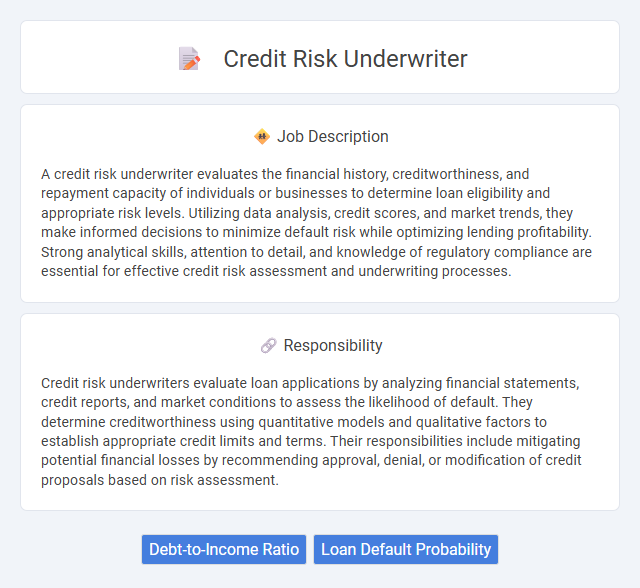
A credit risk underwriter evaluates the financial history, creditworthiness, and repayment capacity of individuals or businesses to determine loan eligibility and appropriate risk levels. Utilizing data analysis, credit scores, and market trends, they make informed decisions to minimize default risk while optimizing lending profitability. Strong analytical skills, attention to detail, and knowledge of regulatory compliance are essential for effective credit risk assessment and underwriting processes.
Individuals with strong analytical skills and attention to detail are likely to be well-suited for a credit risk underwriter position, as the role requires assessing financial data to determine creditworthiness. Those who remain calm under pressure and possess good judgment may more effectively evaluate potential risks and make informed decisions. People who prefer routine tasks without much critical thinking might find this job less suitable due to its demand for constant evaluation and risk assessment.
Qualification
A Credit Risk Underwriter must possess a strong background in finance, accounting, or economics, typically holding a bachelor's degree in these fields. Proficiency in financial analysis, risk assessment methodologies, and familiarity with credit scoring models are essential qualifications. Experience with regulatory compliance and knowledge of industry-specific lending criteria significantly enhance the underwriter's ability to evaluate creditworthiness accurately.
Responsibility
Credit risk underwriters evaluate loan applications by analyzing financial statements, credit reports, and market conditions to assess the likelihood of default. They determine creditworthiness using quantitative models and qualitative factors to establish appropriate credit limits and terms. Their responsibilities include mitigating potential financial losses by recommending approval, denial, or modification of credit proposals based on risk assessment.
Benefit
A credit risk underwriter likely benefits from a stable career path with competitive compensation due to the high demand for expertise in assessing borrower reliability. Opportunities for professional growth may arise as experience in analyzing financial data and risk prediction models enhances decision-making capabilities. Access to advanced analytics tools is probably provided, enabling more accurate risk assessments and contributing to improved loan portfolio performance.
Challenge
Credit risk underwriters likely face significant challenges in accurately assessing borrower creditworthiness amid fluctuating economic conditions and incomplete financial data. They probably encounter difficulties balancing risk tolerance with profitable lending, requiring precise judgment to minimize loan defaults. Complex regulatory requirements and evolving market trends may also complicate their decision-making process, increasing the likelihood of critical errors.
Career Advancement
Credit risk underwriters assess borrowers' creditworthiness to mitigate financial losses and ensure sound lending decisions. Mastery of risk analysis tools and regulatory compliance can lead to advancement into senior underwriting roles or management positions within financial institutions. Continuous professional development and certifications like the Chartered Financial Analyst (CFA) or Financial Risk Manager (FRM) significantly enhance career growth opportunities in this sector.
Key Terms
Debt-to-Income Ratio
Credit risk underwriters analyze the Debt-to-Income (DTI) ratio as a critical metric to assess a borrower's ability to manage monthly payments and repay debts. A lower DTI ratio typically indicates better financial health and a reduced risk of default, influencing loan approval decisions and interest rates. Precise evaluation of DTI helps in mitigating potential credit risks and ensuring sound loan portfolios.
Loan Default Probability
Credit risk underwriters specialize in evaluating loan default probability by analyzing borrower credit history, income stability, and debt-to-income ratios to assess repayment capability. They utilize predictive models and statistical tools to quantify the likelihood of default, enabling financial institutions to set appropriate interest rates and loan terms. Accurate risk assessment helps minimize losses and supports portfolio quality by identifying high-risk applicants early in the lending process.
 kuljobs.com
kuljobs.com